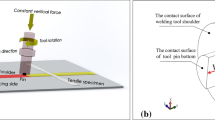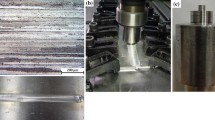Abstract
In this study, the relationship between mechanical and microstructural properties of friction stir welding of 5083 aluminum alloy has been discussed. For this, design of experiment was used to determine minimum number of experiments to evaluate the effect of FSW process parameters on mechanical properties and the welding process was conducted, accordingly. In the experimental stage with proper fixture design, the temperature was measured during the process. Then, tensile, microhardness and bending tests were conducted on the weld samples. Response surface method (RSM) was used to develop a quadratic empirical model to express the ultimate tensile strength as a function of processing parameters. The optimal processing condition was obtained using the developed model. It was found that the appropriate selection of process parameters in friction stir welding of 5083 aluminum alloy improves the mechanical properties which are the result of grain refinement and homogeneity of the microstructure in the stir zone. It was observed that the highest hardness value and bending force have been obtained for the weld with the optimal processing condition obtained by RSM.





















Similar content being viewed by others
References
P. Dabeera and G. Shinde, Perspective of Friction Stir Welding Tools, Mater. Today Proc., 2018, 5(5), p 13166–13176.
R. Nandan, T. Debroy, and H.K.D.H. Bhadeshia, Recent Advances in Friction Stir Welding- Process, Weldment Structure and Properties, Prog. Mater. Sci., 2008, 53(6), p 980–1023.
P. Ulysse, Three-dimensional modeling of the friction stir-welding process, Int. J. Mach. Tools Manuf., 2002, 42(14), p 1549–1557.
R.S. Mishra and Z.Y. Ma, Friction Stir Welding and Processing, Mater. Sci. Eng. R. Rep., 2005, 50(1–2), p 1–78.
A. Shrivastava, M. Krones, and F.E. Pfefferkorn, Comparison of Energy Consumption and Environmental Impact of Friction Stir Welding and Gas Metal Arc Welding for Aluminum, CIRP J. Manuf. Sci. Technol., 2015, 9, p 159–168.
M. Pakdil, G. Çam, M. Koçak, and S. Erim, Microstructural and Mechanical Characterization of Laser Beam Welded AA6056 Al-Alloy, Mater Sci Eng A, 2011, 528(24), p 7350–7356.
A. Bodukuri, K. Eswaraiah, K. Rajendar, and A. Siddartha, Comparison of Aluminum Alloy 5083 Properties on TIGW and FSW Processes, Mater Today Proc, 2017, 4(9), p 10197–10201.
T. Prater, Friction Stir Welding of Metal Matrix Composites for Use in Aerospace Structures, Acta Astronaut., 2014, 93, p 366–373.
G. Wang, Y. Zhao, and Y. Hao, Friction Stir Welding of High-Strength Aerospace Aluminum Alloy and Application in Rocket Tank Manufacturing, J. Mater. Sci. Technol., 2018, 34(1), p 73–91.
S. Shanavas, J. Edwin Raja Dhas, and N. Murugan, Weldability of Marine Grade AA 5052 Aluminum Alloy by Underwater Friction Stir Welding, Int. J. Adv. Manuf. Technol., 2018, 95(9–12), p 4535–4546.
ASM International Handbook Committee, Properties and Selection: Nonferrous Alloys and Special-Purpose Materials, vol 2, ASM International, 1992, p 1143–1144.
S.J. Hosseinipour, An Investigation into Hot Deformation of Aluminum Alloy 5083, Mater. Des., 2009, 30(2), p 319–322.
S. Toros, F. Ozturk, and I. Kacar, Review of warm forming of Aluminum-Magnesium Alloys, J. Mater. Process Technol., 2008, 207(1–3), p 1–12.
R. Abdi Behnagh, M.K. Besharati Givi, and M. Akbari, Mechanical Properties, Corrosion Resistance, and Microstructural Changes During Friction Stir Processing of 5083 Aluminum Rolled Plates, Mater. Manuf. Process, 2012, 27(6), p 636–640.
T. Hirata, T. Oguri, H. Hagino, T. Tanaka, S.W. Chung, Y. Takigawa, and K. Higashi, Influence of Friction Stir Welding Parameters on Grain Size AND Formability in 5083 Aluminum Alloy, J. Mater. Sci. Eng. A, 2007, 456(1–2), p 344–349.
S. Amini, M.R. Amiri, and A. Barani, Investigation of the Effect of Tool Geometry on Friction Stir Welding of 5083-O Aluminum Alloy, Int. J. Adv. Manuf. Technol., 2014, 76(1–4), p 255–261.
M. Imam, Y. Sun, H. Fujii, N. Ma, S. Tsutsumi, and H. Murakawa, Microstructural Characteristics and Mechanical Properties of Friction Stir Welded Thick 5083 Aluminum Alloy, Metall. Mater. Trans. A Phys. Metall. Mater. Sci., 2017, 48(1), p 208–229.
M. Akbari, M.R.M. Aliha, S.M.E. Keshavarz, and A. Bonyadi, Effect of Tool Parameters on Mechanical Properties, Temperature, and Force Generation During FSW, Proc. Inst. Mech. Eng. Pt L J. Mater. Des. Appl., 2019, 233(6), p 1033–1043.
L. Fratini and G. Buffa, CDRX Modelling in Friction Stir Welding of Aluminum Alloys, Int. J. Mach. Tools Manuf., 2005, 45(10), p 1188–1134.
M.M. El-Sayed, A.Y. Shash, and M. Abd-Rabou, Finite Element Modeling of Aluminum Alloy AA5083-O Friction Stir Welding Process, J. Mater. Process Technol., 2018, 252, p 13–24.
E. Sharghi and A. Farzadi, Simulation of Strain Rate, Material Flow, and Nugget Shape During Dissimilar Friction Stir Welding of AA6061 Aluminum Alloy and Al-Mg2Si Composite, J. Alloys Compd., 2018, 748, p 953–960.
P. Ebrahimzadeh, H. Baseri, and M.J. Mirnia, Formability of Aluminum 5083 Friction Stir Welded Blank in Two-Point Incremental Forming Process, Proc. Inst. Mech. Eng. Part. E J. Process Mech. Eng., 2018, 232(3), p 267–280.
T. Nakamura, T. Obikawa, I. Nishizaki, M. Enomoto, and Z. Fang, Friction Stir Welding of Non-Heat-Treatable High-Strength Alloy 5083-O, Metals, 2018, 8(4), p 1–17.
B. Bagheri and M. Abbasi, Analysis of Microstructure and Mechanical Properties of Friction Stir Vibration Welded (FSVW) 5083 Aluminum Alloy Joints: Experimental and Simulation, J. Weld. Join., 2019, 37(3), p 243–253.
A. Emamikhah, A. Abbasi, A. Atefat, and M.K. Besharati Givi, Effect of Tool Pin Profile on Friction Stir Butt Welding of High-Zinc Brass (CuZn40), Int. J. Adv. Manuf. Technol., 2014, 71(1–4), p 81–90.
K. Elangovan and V. Balasubramanian, Influences of Pin Profile and Rotational Speed of the Tool on the Formation of Friction Stir Processing Zone in AA2219 Aluminum Alloy, Mater. Sci. Eng. A, 2007, 459(1–2), p 7–18.
N. Dialami, M. Cervera, M. Chiumenti, A. Segatori, and W. Osikowicz, Experimental Validation of an FSW Model with an Enhanced Friction Law: Application to a Threaded Cylindrical Pin Tool, Metals, 2017, 7(11), p 1–14.
M. Masoumi Khalilabad, Z. Yasser, D. Texier, M. Jahazi, and P. Bocher, Effect of Tool Geometry and Welding Speed on Mechanical Properties of Dissimilar AA2198-AA2024 FSWed Joint, J. Manuf. Process, 2018, 34, p 86–95.
J. Krell, A. Röttger, K. Geenen, and W. Theisen, General Investigations on Processing Tool Steel X40CrMoV5-1 with Selective Laser Melting, J. Mater. Process Technol., 2018, 255, p 679–688.
R. Kumar, R. Singh, and I.P.S. Ahuja, Friction Stir Welding of ABS-15Al Sheets by Introducing Compatible Semi-Consumable Shoulder-Less Pin of PA6-50Al, Measurement, 2019, 131, p 461–472.
A. Goyal and R. Kumar Garg, Parametric Optimization of Friction Stir Welding Process for Marine Grade Aluminum Alloy, Int. J. Struct. Integr., 2019, 10, p 162–175.
C. Chanakyan, S. Sivasankar, M. Meignanamoorthy, M. Ravichandran, and T. Muralidharan, Experimental Investigation on Influence of Process Parameter on Friction Stir Processing of AA6082 Using Response Surface Methodology, Mater. Today: Proc., 2020, 21, p 231–236.
AWS B1.11M/B1.11:2015, Guide for the Visual Examination of Welds, American Welding Society.
ASTM E8/E8M-16a, Standard Test Methods for Tension Testing of Metallic Materials, 2016.
Y. Chen, H. Ding, J. Li, Z. Cai, J. Zhao, and W. Yang, Influence of Multi-Pass Friction Stir Processing on the Microstructure and Mechanical Properties of Al-5083 Alloy, Mater. Sci. Eng. A, 2016, 650, p 281–289.
D.C. Montgomery, Design and Analysis Of Experiments, Wiley Inc, Hoboken, 2012.
K. Mallieswaran, R. Padmanabhan, and V. Balasubramanian, Friction Stir Welding Parameters Optimization for Tailored Welded Blank Sheets of AA1100 with AA6061 Dissimilar Alloy Using Response Surface Methodology, Adv. Mater. Process. Technol., 2018, 4(1), p 142–157.
M. Sarvghad Moghaddam, R. Parvizi, M. Haddad-Sabzevar, and A. Davoodi, Microstructural and Mechanical Properties of Friction Stir Welded Cu-30Zn Brass Alloy at Various Feed Speeds: Influence of Stir Bands, Mater. Design, 2011, 32, p 2749–2755.
A. Farzadi, M. Bahmani, and D.F. Haghshenas, Optimization of Operational Parameters in Friction Stir Welding of AA7075-T6 Aluminum Alloy Using Response Surface Method, Arab. J. Sci. Eng., 2017, 42, p 4905–4916.
M. Ghaffarpour, B.M. Dariani, A. Hossein Kokabi, and N.A. Razani, Friction Stir Welding Parameters Optimization of Heterogeneous Tailored Welded Blank Sheets of Aluminum Alloys 6061 and 5083 Using Response Surface Methodology, Proc. Inst. Mech. Eng. B, 2012, 226, p 2013–2022.
M. Guerra, C. Schmidt, J.C. McClure, L.E. Murr, and A.C. Nunes, Flow Patterns During Friction Stir Welding, Mater. Charact., 2002, 42, p 95–101.
A. Esmaeili, M.K. Besharati Givi, and H.R. Zareie Rajani, A Metallurgical and Mechanical Study on Dissimilar Friction Stir Welding of Aluminum 1050 to Brass (CuZn30), Mater. Sci. Eng. A, 2011, 528, p 7093–7102.
Author information
Authors and Affiliations
Corresponding author
Additional information
Publisher's Note
Springer Nature remains neutral with regard to jurisdictional claims in published maps and institutional affiliations.
Rights and permissions
About this article
Cite this article
Emamikhah, A., Kazerooni, A. & Rakhshkhorshid, M. A Mechanical and Microstructural Study on Friction Stir Welding of 5083 Aluminum Alloy Based on Optimal Values of the Response Surface Method. J. of Materi Eng and Perform 31, 9448–9461 (2022). https://doi.org/10.1007/s11665-022-06901-6
Received:
Revised:
Accepted:
Published:
Issue Date:
DOI: https://doi.org/10.1007/s11665-022-06901-6




